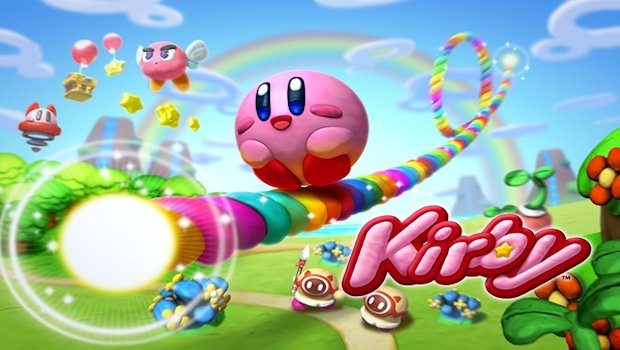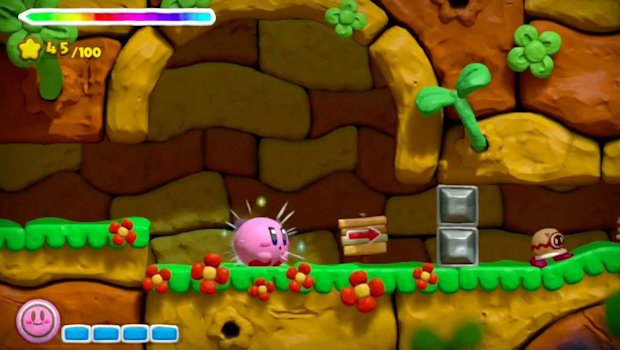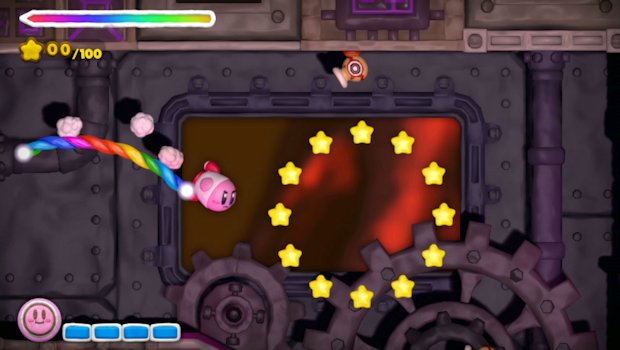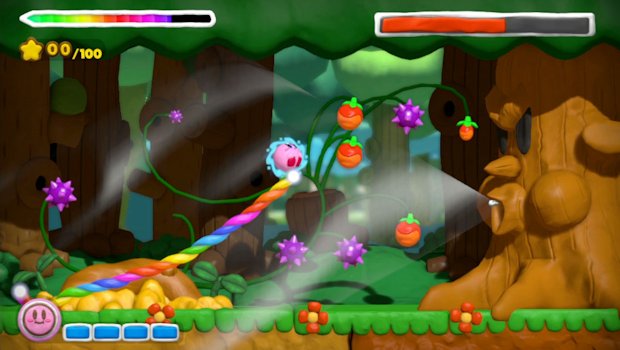Of all Nintendo franchises, Kirby is the guest who shows up to the party uninvited, but nobody has the heart to ask him to leave. He is too inoffensive and forgettable to bother. Even Nintendo doesn’t seem to know what to do with him, as the franchise often strays from its extremely easy 2D platforming roots. Such is the case with Kirby and the Rainbow Curse for Wii U. Like its Nintendo DS predecessor, Kirby: Canvas Curse, Rainbow Curse is a path-drawing game in much the same vein as Line Rider and surely countless other mobile games. However, that description is reductive and sells the game short. Rainbow Curse is spectacular.
It is, in fact, an inventive and challenging 2D platformer with a non-traditional control scheme. You have no direct control over Kirby as he helplessly rolls and bounces through the game’s gorgeous claymation worlds. Instead, you can tap Kirby to make him dash and draw paths of rainbow rope to guide him. There is a limited supply of rope, indicated by a meter at the top of the screen, which replenishes after a quick break in drawing. If you are navigating Kirby through a particularly long gap without platforms, the limited rope can lead to perilous situations where confident drawing becomes essential. If you freak out from the enemies and obstacles being thrown your way and just start drawing lines in a desperate attempt to stay alive, you are likely to run out of rope and fall to your death.
And die you will. Although the game is designed around the ropes you draw for Kirby, it never limits or simplifies the experience to compensate for your limited control. It presents a fully realized 2D platforming world, full of puzzles, secrets, and challenges, and it never pulls any punches. The controls enhance the experience, amplifying the thrill and difficulty, without the game ever making sacrifices to level design.
Nowhere is this truer than in the boss fights. These aren’t 2D Mario bosses that you can easily stomp three times by drawing a line toward their heads. They will shoot lasers at you. They will throw enemies at you. They will chase you around their tiny arenas with their massive bodies surrounded by electrified barriers that will kill you. They would be challenging in any platformer, Take away direct control, and it’s not exactly easy to maneuver away from their attacks and implement a strategy of your own.
The rope-drawing mechanic is also used in other interesting ways beyond just guiding Kirby through levels. It can shield Kirby, solves puzzles, clear obstacles, guide weapons and more. If a wall of lava blocks your way, draw a line through it near the top, and the rope will block the lava, allowing you to progress. In one early example, there is a room you can’t reach with a switch you must activate. This puzzle is solved by simply drawing a line from a boulder in that room to the switch. The boulder rolls along the rope on its own toward the switch without Kirby having to get into the room. As previously stated, this is a full-on platformer with lots of nooks and crannies to explore.
Although Kirby can’t absorb his enemies’ traits like in more traditional Kirby games, there are levels where he transforms into vehicles such as a rocket or submarine. These levels control and play slightly differently from the rest of the game. For instance, as the submarine, you tap where you want to go on the screen, and the submarine goes there on its own. It constantly shoots missiles, and you draw lines to guide the missiles. These vehicle levels are among the least interesting in the game. They aren’t terrible, but they are nowhere near as engaging as the regular levels, and they feel like they exist mostly to provide variety to the experience.
There is little in the way of true disappointment in the game. The multiplayer, which allows up to four-player couch co-op, feels tacked on. Extra players can join Kirby as other characters controlled by traditional input. Playing as these other characters isn’t nearly as fun as drawing your way through a level as Kirby. It’s nice that it exists as an option so that your friends or partner join in, but it doesn’t feel like much thought went into the multiplayer. In one level I played with my girlfriend, Kirby rides a gondola across a series of ropes, but there was no second gondola for her character or any other way for her to keep up with me in the level except dying and respawning.
Although inherent to the gameplay, it’s also a shame that you spend most of your time looking at the gamepad. The graphics look fine on the gamepad, but they don’t quite match how beautiful the claymation HD visuals look on your TV. There is no way around it except to look at your TV and draw blindly, hoping for the best.
The game features 28 levels spread across seven worlds. It may not sound like much, but getting through the main story will take most players a minimum of six hours, and in most cases eight or more. (In fact, the levels are a bit longer than I tend to like in most 2D platformers.) It feels like a complete, satisfying platorming experience and justified as a full retail game. I did not feel the same way about Captain Toad, despite it boasting more levels. Both games released at a budget price of $40; I would have gladly paid more for Rainbow Curse, whereas Captain Toad feels like glorified Mario DLC. The last two worlds in particular become increasingly challenging to the point where you will have to replay most levels many times. Replay value is extended through a challenge mode, as well as replaying levels to 100% the game and get all the collectible music and figurines.
Maybe it’s a case of going in with low expectations, but I came away more than pleasantly surprised by Kirby and the Rainbow Curse. I love it. It feels like an essential part of my Wii U library. It is also worth noting that the game is a unique, exclusive console experience that just isn’t possible on PS4 or Xbox One. Of course, it could be done on a handheld like 3DS (and I did fear the game would feel stretched thin on Wii U), but no other home console can do this game. Nintendo finally tapped into at least some of the potential of its innovative controller. The company should keep going down this path for the rest of Wii U’s life cycle. Give us a Pokemon Snap game where the gamepad is the camera. Throw in some augmented reality levels. Go crazy.
But for right now, for once, I’m happy Kirby showed up to the party.



